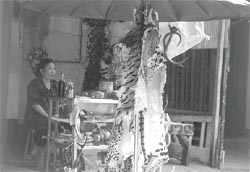THAILAND
 Wildlife experts studying Thailand's tigers have reported that fewer than 150 tigers are left in the Khai Yai National Park and poachers are fast targeting the surviving ones. The poachers, mostly poor villagers from settlements surrounding the national park, are hunting the tiger on a large-scale, as their body parts such as the pelt, bone and penis can easily fetch up to us $ 10,000.
Wildlife experts studying Thailand's tigers have reported that fewer than 150 tigers are left in the Khai Yai National Park and poachers are fast targeting the surviving ones. The poachers, mostly poor villagers from settlements surrounding the national park, are hunting the tiger on a large-scale, as their body parts such as the pelt, bone and penis can easily fetch up to us $ 10,000.
"They are worth more dead than alive,' says Timothy Redford, the coordinator of the Khao Yai conservation project. As the economy is improving in China people are getting more inclined towards buying body parts of various animals and, therefore, such crimes have increased, Redford added.
Experts working on tiger conservation projects, run by the us -based Wildlife Conservation Society and Wildaid, are studying 15 forest regions where tigers dwell. According to them, the initial results of their study has been disappointing. "So far, our surveys conducted in three important forest complexes have shown that the density of tigers is only a fraction of what was anticipated,' says Tony Lynam, the tiger expert of the project.
But the team has not given up on the tigers of Khao Yai. They are hopeful that Thailand's tiger population can be revived. According to them, to achieve this purpose it is very necessary to protect the forest, train the rangers better and seek the cooperation of the villagers.
Related Content
- Unleashing the full potential of industrial clusters: Infrastructure solutions for clean energies
- Integrating co-benefits into Nationally Determined Contributions, climate policies and air pollution policies in Asia
- Fossil fuel subsidies and GHG emissions: firm-level empirical evidence from developing Asia
- International labour migration in a changing climate: insights from Malaysia and Thailand
- Thailand’s clean electricity transition: how accelerated deployment of renewables can help achieve Thailand’s climate targets
- Modeling traffic congestion effects on air pollutants
